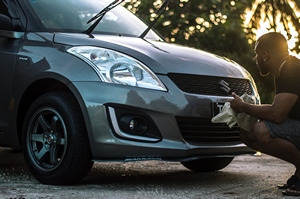|
By accessing/using The Crittenden Automotive Library/CarsAndRacingStuff.com, you signify your agreement with the Terms of Use on our Legal Information page. Our Privacy Policy is also available there. |
Wake Up Your Classic Car From Hibernation In Three Easy Steps
Winter is widely regarded as the worst season to drive.
17 percent of all car crashes in the US happen as a direct result of winter conditions, according to the National Highway Traffic Safety Administration. Hence why most people, especially classic car owners, choose to lay up their cars over the winter. While
design standards for road systems have been improving over the years, it’s simply too big a risk to have one’s car active during the winter months. But keeping a car inactive through an entire season comes with its disadvantages too. If you’re reviving a classic car from hibernation, make sure you follow these essential checks.
Give Your Car a Preliminary Look-Over
First things first, check for damage in parts most likely to get damaged or otherwise inoperable. Ideally, you would do this a few days before you intend to start using the vehicle again. Start from the outside and work your way inward. Check for flat tires, leaks underneath, cracks on the headlights, and stuck doors, wipers, and rear view mirrors. While you’re checking underneath, you might want to look out for anything you can run over as well. After that, pop the hood and check your belts, hoses, ignition points, and other corrosion-prone parts for any signs of corrosion. Mild corrosion can be buffed away with sandpaper, but replacements may be in order for anything extensive.
Once you’ve verified that everything’s in order, get in and try to start it up. Don’t forget to remove your exhaust plug beforehand. Check again for any signs of leakage. If your battery has any sort of difficulty starting your engine, have it charged or buy a new one. Depending on how well-maintained your classic car was before you got it, it may have hidden electrical draws and faulty connections that could exacerbate the battery drain from extreme weather conditions. If that’s the case, it would be more likely for your car to stall. Save yourself the trouble by charging or replacing your battery right away, and have your car checked for electrical inefficiencies while you’re at it.
Pay Attention to Your Car Fluids
The fluids in your car are one of the first things to be affected by low temperatures. Everything from brake fluid, oil, fuel, and even antifreeze can grow viscous and clog up. Check the condition of each and replace as needed. If you have been using modern engine oils for your classic car and its engine has not been overhauled to modern standards, switch to the oil originally recommended by the manufacturer, and strictly follow the prescribed changing intervals. This will help you avoid drastic viscosity changes that will force you to change your oil before waking the car up from hibernation.
Similarly, you would need to do the same for other car fluids. Modern fuels have higher ethanol levels, which can accelerate wear and clog up faster in a classic car. Manufacturers of classic cars warn that modern
E10 fuel can be dangerously corrosive to your car’s fuel system, as well as pose other harmful effects. If you do change to your car’s originally prescribed fuel, keep in mind that lower-octane
gasoline has a shelf life as short as three months or less. If you have had 87 octane fuel sitting in the tank all winter, it may be best to swap it out from some fresh fuel. 92 octane and above keep best over long periods, often lasting up to 9 months before noticeable deterioration.
Go For a Test Drive
Taking the car out for a spin is an essential part of waking it up from hibernation. This will let you test out whether your initial checks and refreshments on the vehicle were effective. Take it out for a few laps and check for anything that feels awry. Address any warning indicators. As you drive, test the brakes with both abrupt and gentle stops. Try to feel and listen for subtle signs of suspension issues, and make sure the transmission shifts gears without difficulty.
Storing cars over the winter is perhaps the most sensible thing to do if you live in a snowy region, and doubly so if your car is as valuable as a classic. Just make sure to shake off all of the ill effects of your vehicle’s hibernation before taking it on a first spring ride.

















 Stock photo, Suzuki Swift by Sleepi Alleyne.
Stock photo, Suzuki Swift by Sleepi Alleyne.
